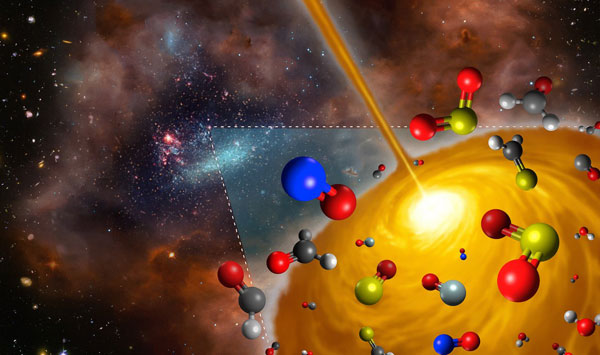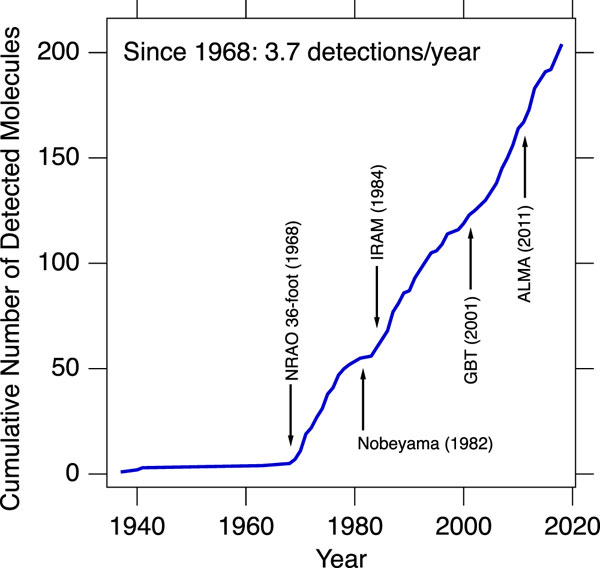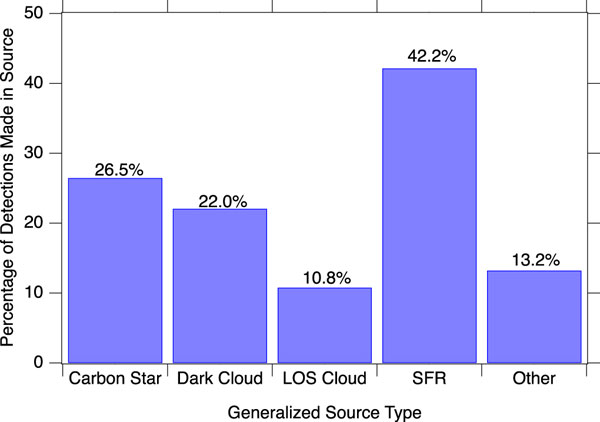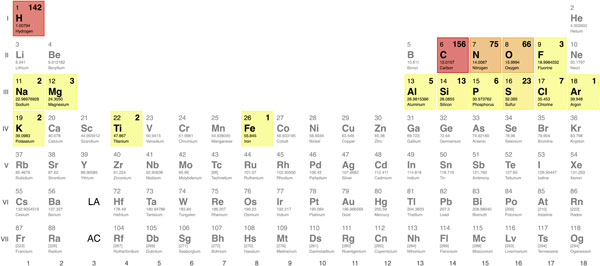What do methylidyne, cyanamide, vinyl alcohol, and rugbyballene all have in common? They’re all molecules that have been detected in space — and they’re all included in a recent census of our universe’s chemical makeup.

FRIS / Tohoku University; ESO / M. Kornmesser; NASA / ESA / S. Beckwith (STScI) / HUDF Team; Hubble Heritage Team (AURA / STScI) / HEI
Looking For Complexity

McGuire 2018
Since the first detection of methylidyne (CH) in the interstellar medium in the 1930s, scientists have been on the lookout for the many molecules — groups of two or more atoms held together by chemical bonds — they know must exist beyond our own planet.
Observations of molecules can help us to understand the chemical evolution of the interstellar medium, the formation of planets, and the physical conditions and processes of the universe around us. But molecules produce complex spectral features that are difficult to correctly attribute, making definitive observations of specific molecules challenging — which means that we’re still only just beginning to understand the chemical composition of our universe.
In a recent publication, scientist Brett McGuire (Hubble Fellow of the National Radio Astronomy Observatory, Harvard-Smithsonian Center for Astrophysics) provides an overall summary of observed interstellar, circumstellar, extragalactic, protoplanetary-disk, and exoplanetary molecules. This publication marks the first “living paper” published in AAS journals — a paper that will continue to be updated over years to come as our observations amass and our understanding of the universe around us grows.
Location, Location, Location

McGuire 2018
McGuire’s census, which includes observations from dozens of facilities across the electromagnetic spectrum, identifies the molecules that have been discovered in various locations.
- Interstellar and circumstellar molecules
All of the molecules that we’ve detected beyond Earth have been spotted in the interstellar or circumstellar medium in our galaxy. In total, 204 different molecules have been identified, ranging in size from two atoms (like methylidyne) to 70 atoms (like rugbyballene, C70). - Extragalactic molecules
67 of the known interstellar and circumstellar molecules (33%) have also been detected in observations of external galaxies. - Protoplanetary-disk molecules
Only 36 of the known interstellar and circumstellar molecules have been found in protoplanetary disks, in part due to the harsh physical environment around young stars and the challenge of maintaining gas-phase molecules under these conditions. - Exoplanetary molecules
Just five molecules — CO, TiO, H2O, CO2, and CH4 — have been found in exoplanetary atmospheres thus far.

McGuire 2018
Analyzing Detections
What can we learn from this census? It’s interesting to note that the entirety of the known molecular inventory is constructed from just 16 of the 118 known elements. As for where they form, more than 90% of the detected molecules were made in a carbon star, a dark cloud, a diffuse/translucent/dense cloud that lies between us and a background source, or a star-forming region.
McGuire points out that our detection of new molecules has progressed at a fairly constant rate since the 1960s. Nonetheless, there are many prospects for future advances — such as the upcoming James Webb Space Telescope’s ability to study exoplanet atmospheres in greater detail. Be sure to check back with this living paper in the future to see how our knowledge of the universe’s chemistry changes!
Citation
“2018 Census of Interstellar, Circumstellar, Extragalactic, Protoplanetary Disk, and Exoplanetary Molecules,” Brett A. McGuire 2018 ApJS 239 17. doi:10.3847/1538-4365/aae5d2
This post originally appeared on AAS Nova, which features research highlights from the journals of the American Astronomical Society.
 0
0









Comments
You must be logged in to post a comment.